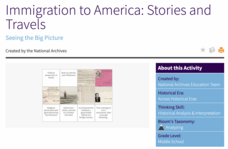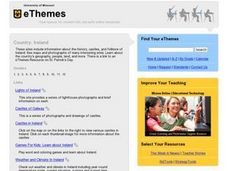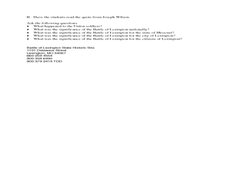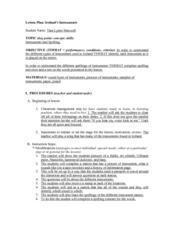Google
Google Translate
Not sure how to translate a word, phrase, or paragraph? No worries. Simply paste in, type, or dictate your text, select the initial and desired language, and up pops your translation. Better yet, the app will read the text to you in most...
University of Richmond
Foreign-Born Population 1850-2010
If America is a nation of immigrants, where are they from and why did they come? Demographic data and interactive maps help pupils consider answers to these questions by examining the statistics of foreign-born Americans. Features allow...
DocsTeach
Immigration to America: Stories and Travels
An eye-opening activity uses documents and photos to help academics understand the factors that pushed or pulled immigrants to America. Young historians group photos based on a push or pull factor, then complete a worksheet. Scholars...
Curated OER
Dig Into Ireland
Learners study Ireland and its distinctive culture. For this exploring Ireland lesson students view a program on Ireland, answer questions then divide into groups and research the Irish connection.
Curated OER
Canadian History: City In Transition
Twelfth graders create an electronic presentation documenting information about St. John, New Brunswick, Canada. Using research from an interactive web exhibit, 12th graders create a PowerPoint presentation documenting the human...
Curated OER
St. Patrick Word Search
In this holiday worksheet, students learn the origin of St. Patrick's Day by reading a paragraph about its history. Students complete a 20 example word search puzzle. Note: There are some religious references in the paragraph and the...
Curated OER
Nevada Mines 1850-1880
Students explore the Nevada mining of 1850-1880. In this history lesson, students investigate the Comstock Lode and examine the mining tools that were used to search for silver and gold.
Curated OER
St. Patrick's Day
In this St. Patrick's Day worksheet, students complete a 10 question multiple choice on-line interactive quiz about the history and traditions of St. Patrick's Day.
Curated OER
Dress in the 14th Century
In this history worksheet, learners explore the clothing styles of the 14th century. Students draw a picture of a knight or a girl. They answer questions about various items of clothing.
Curated OER
Greek Mythology -- Part II
Students use the internet to gather information about Greek Mythology. They discover the role of the snake and shamrock and the history of St. Patrick's Day. They compare and contrast their culture to another.
Curated OER
Inclusive Celebrations
Students discover how celebrations evolve. They explore the history of Halloween. Students devise an inclusive celebration for the end of school term. They create an illustrated pamphlet.
Curated OER
Country: Ireland
Students use the Internet to examine the history, castles, and folklore of Ireland. Photographs of sites are also included.
Curated OER
The Battle of Lexington
Students discover the Missouri River and its importance during the Civil War. In this U.S. history lesson, students examine a map of the great Battle of Lexington, and discuss why the Missouri River was a key element to the...
Curated OER
Ireland's Instruments
Students examine different types of instruments from Ireland. They view pictures of a fiddle, tin whistle, Uilleann pipes, Mandolin, hammered dulcimer, and harp and listen to a recording of each instrument. At each listening station,...
Curated OER
The Power of Storytelling
Young scholars are creating their own stories to understand life. The use of history is used to help one to create one's own story. The skill of writing is emphasized as a tool to learn history.
Curated OER
Daruma
Students study the significance of the daruma through history since the sixth century. Students discuss good luck symbols used by other cultures. Students make a paper mache daruma, filling one eye and setting a goal.
Curated OER
Limericks
Students use the Internet to find examples of limericks. They discover the culture and history of Ireland. They create their own limericks and share them with the class. They offer strengths and weaknesses.
Curated OER
The Welcome Wagon
Students demonstrate an understanding of the immigrant experience in their state. In this immigrant lesson, students listen to immigrant speakers to their state and what their lives were like. Students write brief reports or complete...
Curated OER
Mills of New Hampshire
Students locate mill sites on a New Hampshire map. They describe who worked in the mills and their working conditions. They examine the environmental impact of the mills and work together to find out more information about mills.
Curated OER
Ireland: The Landscape
Students imagine they are taking a trip around Ireland. They create a nature journal for their trip including the description of the landscape, climate, animals and plants. They are to give details to make it seem real. Students may use...
Curated OER
Today and Yesterday: The Praties They are Small
Students explore the tragic circumstances of the Great Famine of 1845-1849. They watch a program that explores the causes and consequences of the famine. Students discuss the causes of the famine. They identify the effects and...
Curated OER
St. Patrick's Day Art Projects
Activities to make March 17th more than just a day for the wearing of the green!
Ancient Order of Hibernians
Who Was Saint Patrick?
Scholars discover who Saint Patrick was with help from a brief informational text followed by a series of challenge worksheets designed to boost reading comprehension and vocabulary. Class members complete a graphic organizer, take...
Central Oregon Community College
Things Fall Apart Study Guide
“There is no story that is not true.” And Chinua Achebe’s Things Fall Apart, uses proverbs (“. . .the palm-oil with which words are eaten”), a compelling tragic hero, and historic events, to engage readers in the truth of his story of...
Other popular searches
- History of Irish Music
- Lesson Plans Irish History
- History Irish Famine
- History Irish History
- Irish History Potato Famine
- History of Irish Famine
- Apiece of Irish History

























